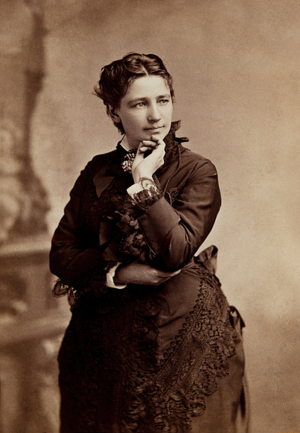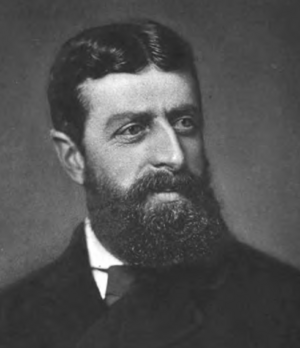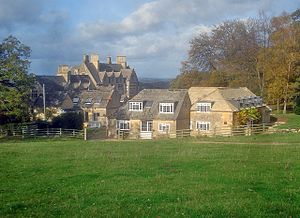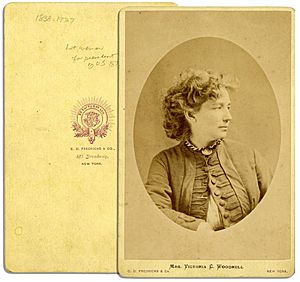Victoria Woodhull facts for kids
Quick facts for kids
Victoria Woodhull
|
|
|---|---|
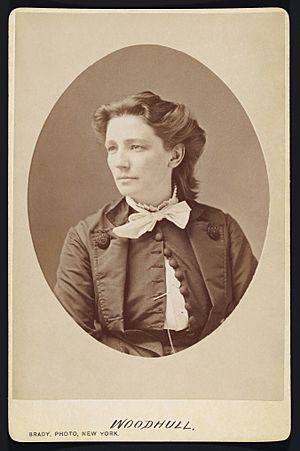 |
|
| Born |
Victoria California Claflin
September 23, 1838 Homer, Ohio, U.S.
|
| Died | June 9, 1927 (aged 88) Bredon's Norton, Worcestershire, England
|
| Occupation | Suffragist, politician, feminist, writer |
| Known for | Politics, women's rights, women's suffrage, feminism, civil rights, anti-slavery, stockbroker, journalism |
| Political party | Equal Rights |
| Spouse(s) |
Canning Woodhull
(m. 1853; div. 1865)John Biddulph Martin
(m. 1883; died 1897) |
| Children | 2 |
| Relatives | Tennessee Claflin (sister) See Claflin family |
| Signature | |
Victoria Claflin Woodhull, later known as Victoria Woodhull Martin (born September 23, 1838 – died June 9, 1927), was an important American leader in the women's suffrage movement. This movement worked to gain voting rights for women. She ran for President of the United States in the 1872 election. Many historians believe Woodhull was the first woman to run for president. Some people questioned her candidacy because she was younger than the required age of 35 at the time of the election. However, newspapers at the time did not focus on her age as a major problem.
Victoria Woodhull became wealthy twice in her life. First, she earned money as a "magnetic healer," a type of alternative medicine. Later, she became involved in the spiritualism movement, which involved beliefs about communicating with spirits. With her sister, Tennessee Claflin, she made history as the first woman to open a brokerage firm on Wall Street. This helped them earn a lot of money. They were also among the first women to start a newspaper in the United States, called Woodhull & Claflin's Weekly, which began in 1870.
Woodhull was very active in politics in the early 1870s. She was nominated as the first woman candidate for the U.S. presidency. In 1872, she ran for the Equal Rights Party. This party supported voting rights for women and equal rights for all. Her running mate was the famous abolitionist leader Frederick Douglass, though he did not know about or accept the nomination. Her campaign encouraged other women to get involved in politics.
Contents
Victoria's Early Life
Victoria California Claflin was born in Homer, Ohio, a small town. She was the seventh of ten children. Her mother, Roxanna Claflin, could not read and followed the spiritualist movement. Her father, Reuben Claflin, was a lawyer.
Victoria believed in spiritualism. She felt it gave her hope for a better life. As she grew up, Victoria became very close to her younger sister, Tennessee Celeste Claflin (Tennie). As adults, they worked together to start a stock brokerage and a newspaper in New York City.
Victoria only had three years of formal schooling by age 11. However, her teachers thought she was very smart. She had to leave school and home with her family after her father had problems with the law. The town helped her family leave Ohio.
Victoria's Marriages
First Marriage and Family
When Victoria was 14, she met Canning Woodhull, a 28-year-old doctor. Her family had asked him to treat her for a long-term illness. They were married on November 20, 1853. Victoria was just over 15 years old.
Victoria and Canning had two children: Byron and Zulu (later called Zula) Maude Woodhull. Byron was born in 1854 with an intellectual disability. After their children were born, Victoria divorced Canning but kept his last name.
Second Marriage
Around 1866, Victoria married Colonel James Harvey Blood. He had served in the Union Army during the American Civil War. This was his second marriage, too.
Victoria's Careers
Becoming a Stockbroker
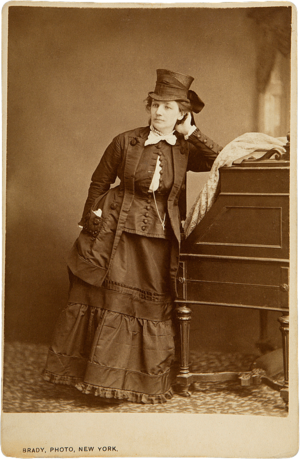
In 1870, Victoria Woodhull and her sister Tennessee (Tennie) Claflin made history. They became the first female stockbrokers and opened their own brokerage firm on Wall Street. This shocked many people. Newspapers called them "the Queens of Finance."
They opened "Woodhull, Claflin & Company" with help from the rich Cornelius Vanderbilt. He admired Woodhull's spiritual abilities. Woodhull made a lot of money on the New York Stock Exchange by giving good advice to clients like Vanderbilt. For example, she once told him to sell his shares, and he earned millions.
Starting a Newspaper
On May 14, 1870, Woodhull and Claflin used their money to start a newspaper. It was called Woodhull & Claflin's Weekly. At its peak, 20,000 copies were printed across the country. The main goal of the newspaper was to support Victoria Claflin Woodhull for President.
The Weekly was published for six years. It focused mostly on feminism, which is the belief in equal rights for women. It also became known for publishing bold ideas on topics like women's voting rights, shorter skirts, spiritualism, and vegetarianism.
Some other women's rights leaders, like Susan B. Anthony, did not always agree with Woodhull's methods.
Advocating for Women's Rights
Woodhull learned how to speak in the male-dominated world of national politics. She arranged to speak about women's voting rights to the House Judiciary Committee. In December 1870, she presented her ideas to the Committee. She argued that women already had the right to vote. She said they just needed to use it. She explained that the 14th and 15th Amendments protected this right for all citizens.
Her clear argument impressed some committee members. Other suffrage leaders, like Susan B. Anthony and Elizabeth Cady Stanton, attended the hearing. They saw Woodhull as a new champion for their cause. They liked her statement: "Women are the equals of men before the law, and are equal in all their rights."
After this powerful public appearance, Woodhull became a leader in the suffrage movement. She brought a lot of public attention to women's voting rights. She was the second woman to speak to Congress in person. Many newspapers reported on her appearance. Frank Leslie's Illustrated Newspaper even printed a full-page picture of Woodhull speaking.
Victoria's Presidential Campaign
On April 2, 1870, Woodhull announced her plan to run for president in a letter to the New York Herald.
She was officially nominated for President of the United States by the new Equal Rights Party on May 10, 1872. This happened at Apollo Hall in New York City. This made her the first woman candidate for president.
Her campaign was also special because Frederick Douglass was nominated as her vice-presidential candidate. However, he did not attend the convention or accept the nomination. The Equal Rights Party hoped to bring together women's rights supporters and African-American civil rights activists.
A few days before the 1872 presidential election, U.S. Federal Marshals arrested Woodhull, her second husband, and her sister Tennie. They were held in jail for about a month. They were later found not guilty. This arrest stopped Woodhull from trying to vote in the 1872 election.
Woodhull did not receive any electoral votes in the 1872 election. She tried to get nominated for president again in 1884 and 1892.
Life in England and Third Marriage
In October 1876, Woodhull divorced her second husband, Colonel Blood. After Cornelius Vanderbilt died in 1877, his son paid Woodhull and her sister to leave the country. He was worried they might speak about his father's estate. The sisters accepted and moved to Great Britain in August 1877.
Victoria gave her first public lecture in London on December 4, 1877. It was called "The Human Body, the Temple of God." A banker named John Biddulph Martin attended one of her lectures. They began seeing each other and married on October 31, 1883. His family did not approve of their marriage.
From then on, she was known as Victoria Woodhull Martin. She published a magazine called The Humanitarian from 1892 to 1901 with help from her daughter, Zula. Her husband John died in 1897. After 1901, Victoria stopped publishing and moved to the countryside. She lived at Norton Park in Bredon's Norton, Worcestershire. There, she and her sister built a village school. She became a strong supporter of education reform in English village schools, adding kindergarten lessons.
She was also active in the early days of women driving cars. She was said to be the first woman to drive a car in Hyde Park and on English country roads.
Victoria's Legacy and Honors
- A memorial to Victoria Woodhull Martin is located at Tewkesbury Abbey.
- A historical marker outside the Homer Public Library in Ohio honors Woodhull as the "First Woman Candidate For President of the United States."
- There is a memorial clock tower in her honor at the Robbins Hunter Museum in Granville, Ohio.
- The 1980 Broadway musical Onward Victoria was inspired by her life.
- In 2001, Victoria Woodhull was added to the National Women's Hall of Fame.
- She was honored by the Office of the Manhattan Borough President in March 2008. She was also included on a map of historical sites related to important women.
- On September 26, 2008, she received the "Ronald H. Brown Trailblazer Award" from St. John's University School of Law.
- Victoria Bond composed an opera about Woodhull called Mrs. President, which premiered in 2012.
- In March 2017, Amazon Studios announced a movie based on her life, starring Brie Larson as Victoria Woodhull.
Images for kids
See also
 In Spanish: Victoria Woodhull para niños
In Spanish: Victoria Woodhull para niños
- List of civil rights leaders
- List of suffragists and suffragettes
- List of women's rights activists
- Timeline of women's rights (other than voting)
- Timeline of women's suffrage


